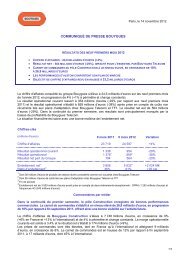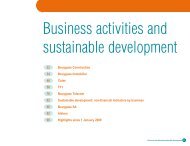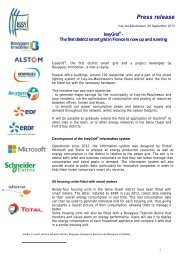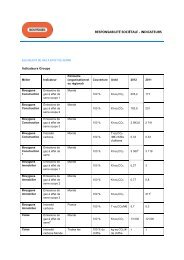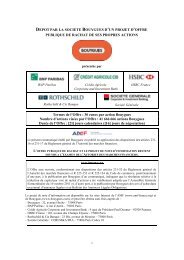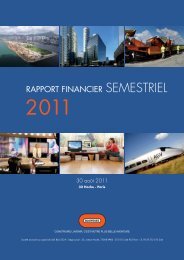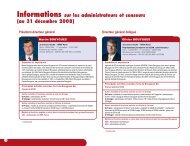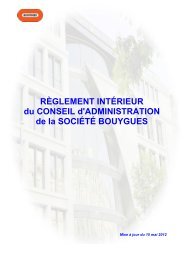Registration Document BOUYGUES
Registration Document BOUYGUES
Registration Document BOUYGUES
You also want an ePaper? Increase the reach of your titles
YUMPU automatically turns print PDFs into web optimized ePapers that Google loves.
Broadcasting rights are recognised as assets,<br />
at historical cost. Dates of initial recognition and<br />
amortisation methods are as follows:<br />
Amortisation method<br />
Initial recognition<br />
> Films co-produced by TF1 Films Production are<br />
amortised in line with revenues over a limited<br />
time-frame, taking account of the timing of<br />
revenue sources; this policy is consistent with<br />
industry practice.<br />
> An impairment loss is recognised against<br />
broadcasting rights on a line by line basis where<br />
estimated future revenues do not cover the carrying<br />
amount of the asset.<br />
2.7.4 Impairment testing – non-current<br />
assets and investments in associates<br />
Impairment tests are carried out on the carrying<br />
amount of intangible assets and investments in<br />
associates if there is objective evidence that they<br />
may have become impaired.<br />
The carrying amounts of indefinite-lived intangible<br />
assets and goodwill are compared to their<br />
recoverable amounts at least at the end of each<br />
financial year.<br />
Categories of broadcasting rights<br />
Film co-production shares Distribution/Trading rights Music rights<br />
In line with revenues<br />
over 8 years<br />
At end of shooting or on receipt<br />
of censor’s certificate<br />
• Distribution = in line with revenues,<br />
minimum 3 years straight line<br />
• Trading: 5 years straight line<br />
On signature of contract<br />
Impairment testing of TF1, Bouygues<br />
Telecom and Colas<br />
In determining the recoverable amount, intangible<br />
assets to which independent cash flows cannot<br />
be directly allocated are grouped within the Cash<br />
Generating Unit (CGU) to which they belong, or<br />
within the appropriate group of CGUs representing<br />
the lowest level at which management monitors<br />
return on investment (business segment level in<br />
the case of the Bouygues group). The recoverable<br />
amount of CGUs is measured as follows:<br />
a) For TF1, which is listed on the stock market and<br />
has good liquidity: on the basis of the quoted<br />
share price if this exceeds the carrying amount<br />
of the assets (after allowing for a control premium);<br />
otherwise, using the Discounted Cash<br />
Flow (DCF) method, taking account of the<br />
specific characteristics of TF1 (see (b) below).<br />
b) For other CGUs: using the DCF method, taking<br />
account of the specific characteristics of the<br />
CGU.<br />
• The cash flows used are derived from the<br />
three-year business plan prepared by the<br />
management of the business segment and<br />
Over 2 years with:<br />
• 75% of gross value in year 1<br />
• 25% of gross value in year 2<br />
On signature of contract<br />
approved by the Boards of Directors of the<br />
entity and of Bouygues SA in December<br />
2011, based on market conditions as of that<br />
date.<br />
• The discount rate is determined using a<br />
weighted average cost of capital appropriate<br />
to the sector in which the segment operates,<br />
by reference to a panel of comparable companies.<br />
• The terminal value is calculated by aggregating<br />
the discounted cash flows to infinity,<br />
based on normative cash flows and a<br />
perpetual growth rate that is consistent with<br />
the growth potential of the markets in which<br />
the business segment operates and with its<br />
competitive position in those markets.<br />
The recoverable amount of the CGU as determined<br />
above is then compared with its carrying amount<br />
in the consolidated balance sheet. If this carrying<br />
amount is greater than the recoverable amount of<br />
the CGU, an impairment loss is recognised. Any<br />
such losses are allocated in the first instance to any<br />
goodwill recognised in the balance sheet, and may<br />
not be subsequently reversed.<br />
Information about goodwill impairment<br />
tests performed for TF1, Bouygues Telecom<br />
and Colas:<br />
• The recoverable amount of TF1, Bouygues<br />
Telecom and Colas was determined using<br />
the method described above, based on<br />
three-year cash flow projections as per the<br />
business plans of each of the three subsidiaries.<br />
• Cash flows beyond the projection period<br />
were extrapolated using a reasonable, sectorspecific<br />
perpetual growth rate.<br />
• The discount rates (weighted average cost of<br />
capital) and growth rates used at end-2011<br />
were as follows:<br />
Discount<br />
rate<br />
Scenario 1 a Scenario 2 a<br />
Perpetual<br />
growth rate<br />
TF1 8.62% 7.70% 2%<br />
Bouygues<br />
Telecom<br />
5.41% 4.91% 2%<br />
Colas 7.02% 6.31% 2%<br />
(a) Depending on the capital structure:<br />
scenario 1 = 1/3 debt, 2/3 equity; scenario 2 = 2/3 debt, 1/3 equity<br />
Impairment testing of the investment in<br />
Alstom<br />
Because goodwill included in the carrying amount<br />
of investments in associates is not shown separately,<br />
it is not tested separately for impairment<br />
under IAS 36. The total carrying amount of the<br />
investment in Alstom was tested for impairment<br />
as at 31 December 2011 by comparing it with the<br />
recoverable amount as derived from forecasts<br />
prepared by a panel of financial analysts.<br />
<strong>BOUYGUES</strong> • 2011 <strong>Registration</strong> <strong>Document</strong> • FINANCIAL STATEMENTS • Consolidated financial statements • 226



